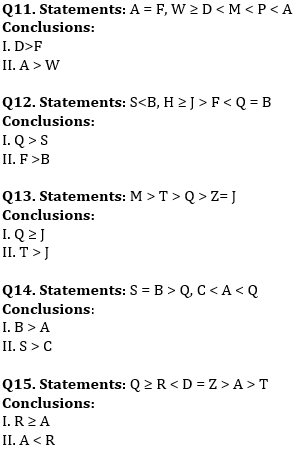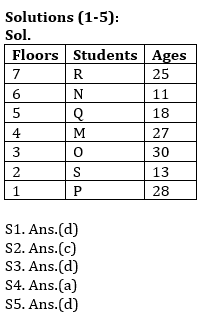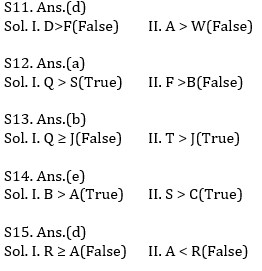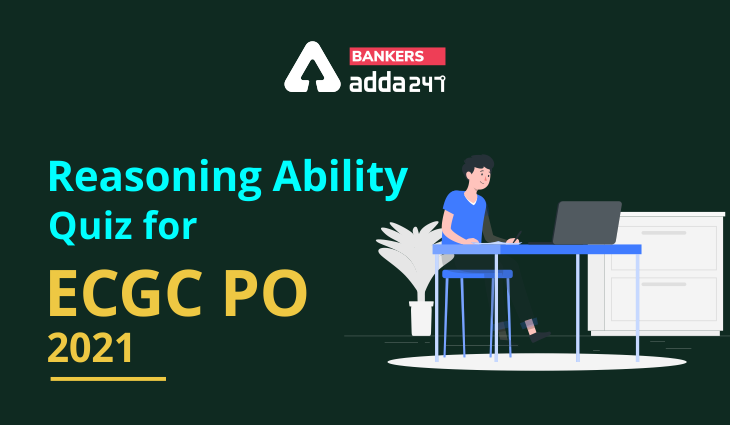Table of Contents
Directions (1-5): Study the following information carefully and answer the question given below:
Seven Students M, N, O, P, Q, R, and S are living on different floors of seven storey building. Ground floor is numbered as 1st and top floor is numbered as 7th floor, also they are of different ages 11, 13, 18, 25, 27, 28, and 30 (not necessarily in same order).
O lives on odd numbered floor but not on topmost floor. S lives one of the even numbered floors below O. There are 2 floors between O and N, who is youngest. Q lives just below N and is 3rd youngest. M lives on even numbered floor and his age is a perfect cube. P doesn’t live above N’s floor. R is younger than M and older than Q. S’s age is a prime number. P is not the oldest.
Q1. Who among the following lives on 4th floor?
(a) R
(b) N
(c) Q
(d) M
(e) None of these
Q2. What is the age of O?
(a) 13
(b) 27
(c) 30
(d) None of these
(e) 25
Q3. How many persons live between S and N?
(a) No one
(b) One
(c) Two
(d) Three
(e) Four
Q4. Who among the following lives on 1st floor?
(a) P
(b) O
(c) M
(d) S
(e) None of these
Q5. Who among the following lives just above the one whose age is 25?
(a) M
(b) Q
(c) N
(d) No one
(e) None of these
Directions (6-10): Following questions are based on the five three-digit given below.
519 328 746 495 837
Q6. If half of the lowest number is subtracted from the highest number, then what will be the value?
(a) 573
(b) 673
(c) 213
(d) 314
(e) None of these
Q7. If the positions of the first and the third digits in each of the numbers are interchanged, which of the following will be the second digit of the lowest number?
(a) 1
(b) 2
(c) 4
(d) 9
(e) 3
Q8. If in each number all digits are arranged in increasing order within the number, then which number is highest number after rearrangement?
(a) 837
(b) 495
(c) 519
(d) 746
(e) None of these
Q9. If in each number all digits are arranged in increasing order within the number, then which number is lowest number after rearrangement?
(a) 495
(b) 837
(c) 519
(d) 746
(e) None of these
Q10. If ‘1’ is subtracted from the third digit of each number and ‘1’ is added to the first digit of each number, which of the following will be the sum of the second and third digits of the second lowest number?
(a) 13
(b) 9
(c) 8
(d) 6
(e) None of these
Directions (11-15): In these questions, relationship between different elements is shown in the statements. These statements are followed by two conclusions.
Mark answer as
(a) If only conclusion I follows.
(b) If only conclusion II follows.
(c) If either conclusion I or II follows.
(d) If neither conclusion I nor II follows.
(e) If both conclusions I and II follow.

Practice More Questions of Reasoning for Competitive Exams:
Reasoning for Competitive Exams |
Reasoning Ability Quiz For ECGC PO 2021- 22nd January |
Reasoning Ability Quiz For ECGC PO 2021- 21st January |
ECGC PO Study Plan 2021 |
Solutions

S6. Ans.(b)
S7. Ans.(d)
S8. Ans.(d)
S9. Ans.(c)
S10. Ans.(a)

Practice with Crash Course and Online Test Series for ECGC PO 2021:
- ECGC Online Coaching Classes for Probationary Officier 2021
- ECGC PO Mock Tests 2021 – Banking Online Test Series (With Solutions) by Adda247
- ECGC PO 2021 Complete eBooks Kit (English Medium)
Click Here to Register for Bank Exams 2020 Preparation Material




 GA Capsule for SBI Clerk Mains 2025, Dow...
GA Capsule for SBI Clerk Mains 2025, Dow...
 The Hindu Review October 2022: Download ...
The Hindu Review October 2022: Download ...
 ECGC PO Scorecard 2025 Out, Check Marks
ECGC PO Scorecard 2025 Out, Check Marks




